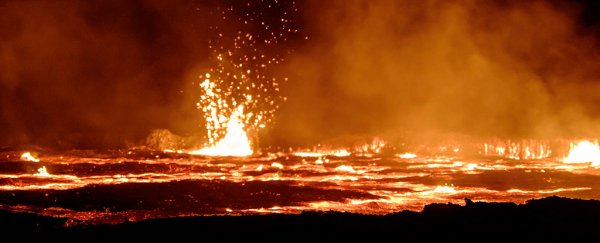NASA satellite imagery has spotted new cracks opening up near Africa's 'Gateway to Hell' – more officially known as the Erta Ale volcano in Ethiopia.
Scientists think nearby tectonic activity is causing large amounts of lava to spill out of the large, flat shield volcano, which features two lava lakes that have been bubbling and burning for decades.
It's one of the most spectacular sights in the natural world – not that you'd want to get too close, with lava temperatures inside these cauldrons reaching as high as 1,100 degrees Celsius (2,012 degrees Fahreneheit).
According to eyewitness reports, the lava lake levels have risen significantly over the past few weeks, producing "massive overflows" and "intense spattering" on top of the new fissures captured by NASA's satellites on the southeastern flank of the volcano, 7 kilometres (4.3 miles) from the summit.
 Joshua Stevens, using Landsat data from the US Geological Survey
Joshua Stevens, using Landsat data from the US Geological Survey
The picture above was captured by NASA's Operational Land Imager (OLI) camera sat on board the Landsat 8 satellite: it combines natural colour and shortwave infrared light signals to identify smoke plumes as well as areas of increased temperature that would normally be invisible to the naked eye.
Where the infrared hot spots are marked in red on the image is where the overflowing lava channels are running.
These are the first flows beyond the volcano's crater that have been seen in a decade, according to Gezahegn Yirgu from Addis Ababa University in Ethiopia.
While the nearby area is uninhabited, lava could could continue to flow towards the town of Afdera, Nazret.com reports, and so needs to be monitored.
The 'Gateway to Hell' and 'Smoking Mountain' nicknames locals use for Erta Vale are well deserved. Set 613 metres (2,011 feet) above sea level, it's one of just five known volcanoes with molten lava lakes, and is the only one on record with two.
The site is part of the Danakil Depression in Ethiopia, where three tectonic plates are sliding away from each other as Africa and Asia move apart. In terms of average temperatures across the year, it's one of the hottest places on the planet.
Shield volcanoes like this are typically large and broad, with gentle slopes. They're primarily built around fluid lava flows, and are less explosive than traditional volcanoes because the chemical make-up of the basalt lava in them is less likely to get plugged up.
How much longer tectonic movement will cause disruptions to Erta Ale isn't clear, but the most recent reports suggest some of the overflowing has now stopped - which means the bravest photographers and tourists can venture back.
Previous visitors include Portuguese travel photographer Joel Santos, who made a dramatic video of his trip.
"Erta Ale is probably the most overwhelming, unreal and mesmerising sight one could see in a lifetime," he told MailOnline.
